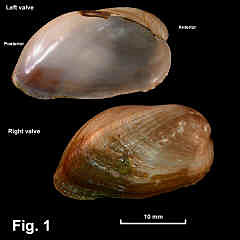|
|
MYTILIDAE |
|
|
|
Musculus cumingianus (Reeve, 1857) Description: Shape equivalve, inequilateral, light in weight, inflated, elongate; umbo set back from anterior end, fairly low, incurved, projecting above dorsal margin. Valves wider posteriorly; anterior end broadly rounded to subtruncate; posterior end subtruncate, elongate in some specimens. Margin not crenulated by external sculpture. Hinge without teeth. Ligament moderately long, curved. Interior smooth, muscle scars obscure, surface weakly nacreous. Exterior with 3 sculptural panels: anterior panel with up to 15 radial ribs; posterior panel with more numerous radial ribs; central panel with only coarse concentric growth ridges. Colour of exterior fawn mottled with brown; interior white with weak purple patches, external sculpture showing through. Periostracum smooth, brown. Size: Available specimens up to 26 mm in length. Distribution: The Australian Museum collection holds specimens from Queensland southwards to Sydney, but see remarks below. Habitat: In NSW this is known from rocky shores intertidally, and from beach washup. It has also been reported as living inside ascidians (sea squirts) (R. Willan, pers. comm.). Comparison: This species differs from M. impactus by being more elongate and lighter in colour. Both species are tinged with purple internally, but more intensely so for M. impactus. The number and strength of ribs is variable, and is not a good character for separating the species. Remarks: There has been no recent revision of Musculus species, so the characterisation and distribution of the species is poorly understood. The name Musculus cumingianus has been commonly used for species in the tropical Indo-West Pacific including Queensland and Western Australia, but until a revision is available there is no certainty that is the correct name for the NSW species or that only one species is being referenced. Fig. 1: Port Jackson, NSW (C.219871) |
|
